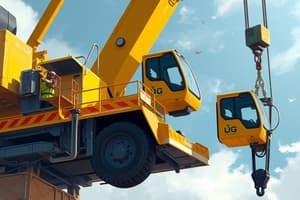Podcast
Questions and Answers
What is the purpose of a document referred to as the 'birth certificate' for lifting equipment?
What is the purpose of a document referred to as the 'birth certificate' for lifting equipment?
- To maintain evidence of the equipment's design specifications.
- To assure compliance with national supply legislation.
- To serve as part of the lifting equipment records. (correct)
- To verify the material used in the equipment's construction.
Which of the following accurately describes the Minimum Breaking Load?
Which of the following accurately describes the Minimum Breaking Load?
- The average load that equipment is expected to lift.
- The specified load below which the equipment does not fail. (correct)
- The load above which the equipment will certainly fail.
- The maximum load that can be safely applied to the equipment.
What defines the Rated Capacity of a lifting appliance?
What defines the Rated Capacity of a lifting appliance?
- The maximum gross load the appliance can lift in any configuration. (correct)
- The expected load during regular operations on an average day.
- The maximum weight an operator can lift safely at any time.
- The minimum weight that must be achieved for operational certification.
What is the primary purpose of a Proof or Test Load?
What is the primary purpose of a Proof or Test Load?
Which statement best describes a Multipurpose Equipment?
Which statement best describes a Multipurpose Equipment?
What is the purpose of a manufacturer's certification in relation to lifting equipment?
What is the purpose of a manufacturer's certification in relation to lifting equipment?
How is the working load limit of lifting equipment determined?
How is the working load limit of lifting equipment determined?
Which statement best defines 'lifting equipment'?
Which statement best defines 'lifting equipment'?
What is the primary purpose of proof load testing for lifting equipment?
What is the primary purpose of proof load testing for lifting equipment?
What is noted in lifting equipment records that is crucial for safety compliance?
What is noted in lifting equipment records that is crucial for safety compliance?
Flashcards
Minimum Breaking Load
Minimum Breaking Load
The specified load below which equipment does not fail from fracture or distortion.
Multipurpose Equipment
Multipurpose Equipment
Equipment designed to lift various loads up to the specified Safe Working Load (SWL).
Operative
Operative
A trained individual responsible for operating the lifting equipment.
Rated Capacity
Rated Capacity
Signup and view all the flashcards
Proof or Test Load
Proof or Test Load
Signup and view all the flashcards
Lifting Equipment
Lifting Equipment
Signup and view all the flashcards
Lifting Accessory
Lifting Accessory
Signup and view all the flashcards
Lifting Appliance
Lifting Appliance
Signup and view all the flashcards
Manufacturer Responsibilities
Manufacturer Responsibilities
Signup and view all the flashcards
Manufacturer’s Documentation
Manufacturer’s Documentation
Signup and view all the flashcards
Study Notes
Document Retention
- Important to retain the ‘birth certificate’ of lifting equipment as part of records, unless national supply legislation specifies otherwise.
Key Industry Definitions
- Minimum Breaking (or Failure) Load: The specified load below which equipment does not fail from fracture or distortion.
- Multipurpose Equipment: Designed to lift various loads up to the specified Safe Working Load (SWL) and not limited to one application.
- Operative: A trained individual responsible for operating the equipment.
- Rated Capacity: The maximum gross load a lifting appliance can lift in any configuration.
- Proof or Test Load: A test load applied by a competent person to assess the equipment's fitness for service.
Importance of Regular Inspection
- Ensures equipment safety for continued use.
- Verifies operator competency in using the equipment.
- Identifies necessary repairs.
- Confirms the correct functioning of the equipment.
- Reassures overall safety during operation.
- Aids in familiarizing oneself with the equipment.
Lifting Equipment Definitions
- Lifting Equipment: A general term encompassing all types of lifting accessories and appliances.
- Lifting Accessory: Also known as lifting gear or rigging equipment, used to connect loads to lifting appliances. This may include shackles, spreader beams, and chain slings.
- Lifting Appliance: Machines that can raise, lower, or suspend loads (e.g., cranes, hoists, jacks), excluding guided loads and continuous handling devices.
Manufacturers Responsibilities
- A manufacturer is any entity responsible for designing or producing lifting equipment, ensuring compliance with legal standards.
- If a designated manufacturer is absent, the entity marketing or putting the equipment into service is considered the manufacturer.
Manufacturer’s Documentation
- Manufacturers typically provide a manufacturer’s certificate, record of test, or statement of conformity, verifying compliance and confirming load limits for safety.
Studying That Suits You
Use AI to generate personalized quizzes and flashcards to suit your learning preferences.




